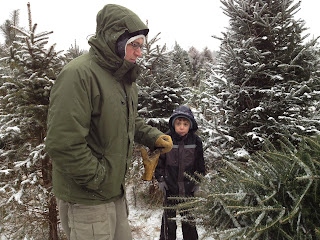Winterizing the Chicken Coop
Q: Why would our chickens' water fount be in the kitchen sink?
A: Because it's frozen.
December came in with a touch of snow, which made for a fun trek to the Christmas tree farm yesterday:
It was pretty, but it was cold. When we got home with the tree, we realized the temperature for the day hadn't climbed out of the 20s. When Kirk looked in on the chickens, he realized that their water had frozen over, so we had to bring it in the house to chip out the ice and refill it.
Time to winterize the coop. About a month ago we picked up a warmer for the water:
For a quick fix last night, we ran an extension cord from the garage to the coop, but today Kirk worked up some permanent wiring:
He dug a trench (lucky me – I got to fill it back in!) and ran a wire underground from the workshop to the run:
From the run the wire goes up through the eave, along the ceiling of the run, and on into the henhouse. Kirk set up an outlet on the wall to plug the warmer into:
We'll keep an eye on the cord to check whether or not the hens peck at it. If so, we'll need to protect that cord and tack it down to wall more carefully. The warmer has a thermostat, so it only comes on when the temperatures fall below 35 degrees. It should be just enough to keep the water liquid and drinkable for them.
They also have a 40-watt bulb that we've been using, increasing the amount of light each day to try to coax them into laying some winter eggs. They're up to about 16 hours of "daylight" now, but we have yet to see any results with this method. If nothing else, the warming tray and bulb will offer the ladies a few extra degrees of warmth, I guess.
In the meantime, we had to add eggs to the grocery list this week. Sigh.









Comments
Post a Comment